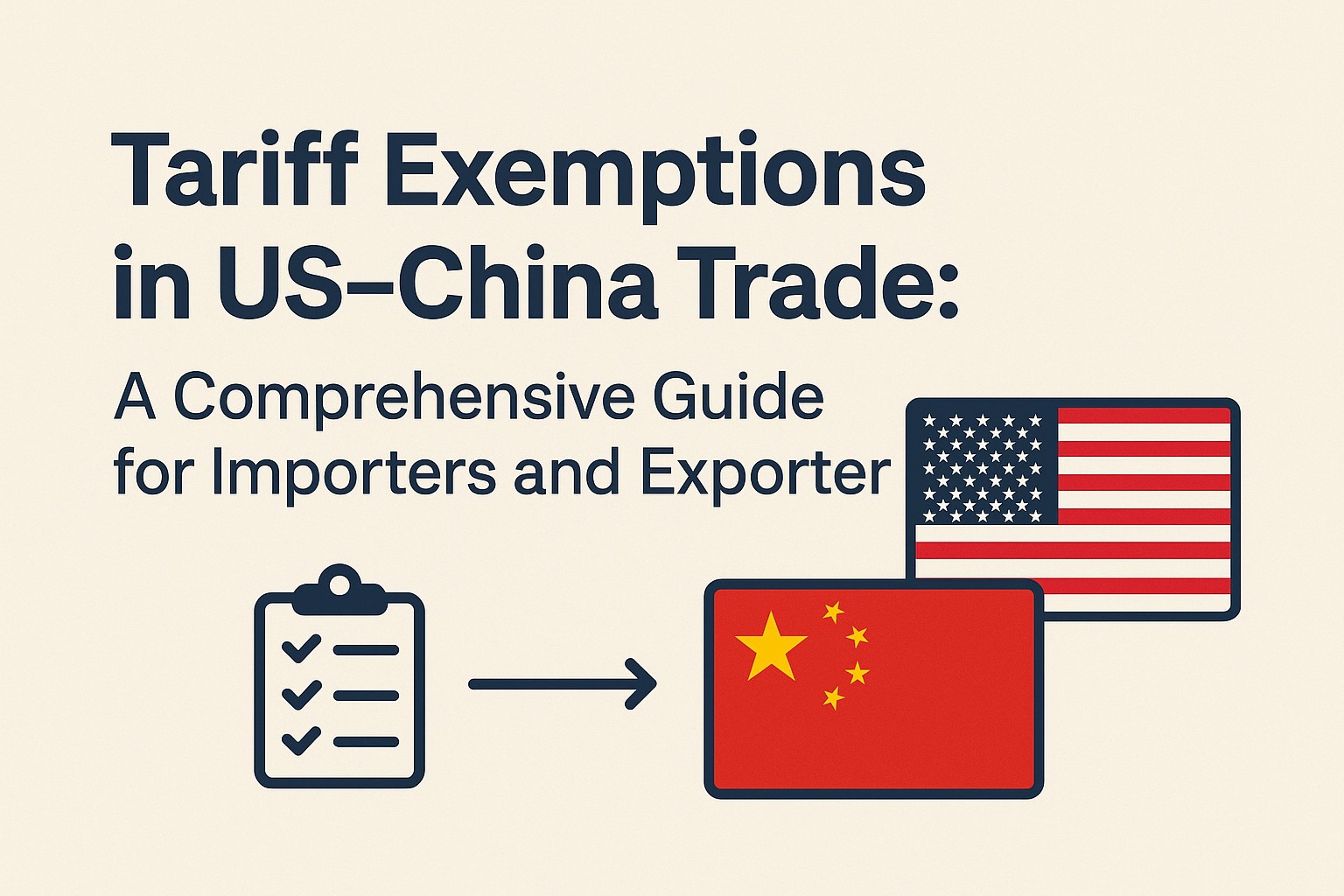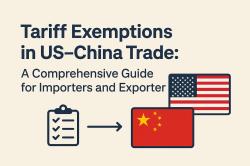Introduction
The US–China trade relationship has been defined by periodic tensions and policy shifts, most notably the imposition of Section 301 tariffs by the United States on a wide range of Chinese imports. These tariffs, initially designed to address concerns over intellectual property practices and trade imbalances, have significantly impacted costs for US businesses reliant on Chinese goods. For importers and exporters alike, navigating this tariff landscape has become a critical operational and strategic challenge.
One key mechanism for mitigating the financial burden of these tariffs is the tariff exemption (or exclusion) process. By securing an exemption, companies can avoid paying duties on specific products, helping to maintain supply chain stability and preserve competitiveness in global markets. Understanding which products qualify, how to apply, and the criteria used by US authorities is essential for businesses looking to leverage these exemptions effectively.
This guide provides a detailed breakdown of tariff exemptions in US–China trade. Readers will gain insight into the qualifying products, the application process, key criteria for approval, and the potential trajectory of future policies—equipping businesses with practical knowledge to manage costs and make informed supply chain decisions.
Which Products Qualify for Tariff Exemptions in US–China Trade?
The Section 301 tariffs are divided into multiple tranches, commonly referred to as Lists 1, 2, 3, and 4A, each covering different product categories and timelines. Exemptions are not uniform and can vary by list, product type, and whether the exclusion is product-specific or company-specific.
Major categories that have historically received exemptions include:
Medical supplies and equipment: Certain surgical instruments, protective gear, and laboratory products.
Industrial components and machinery: Precision tools, electronic components, and parts essential to manufacturing.
Technology-related goods: Items that support US industrial or technological competitiveness.
It’s important to distinguish between general product exclusions, which apply broadly to all importers of a given HTS code, and company-specific exclusions, which grant relief only to the applicant. Companies must ensure they understand which type of exclusion applies to their imports to plan accordingly.
How Can Companies Apply for Tariff Exclusions?
Applications for Section 301 exclusions are handled by the United States Trade Representative (USTR). The process requires careful preparation and submission through official channels. Key steps include:
Documentation: Provide detailed import data, product descriptions, and attempted sourcing alternatives. Supporting evidence should clearly demonstrate why the product is necessary and cannot be sourced elsewhere.
Submission: Follow the USTR’s guidelines, ensuring all required forms and attachments are completed accurately. Applications are typically submitted electronically via the USTR website.
Timeline: Exclusion reviews can take several months. Currently, the focus is on extensions of existing exemptions, though new requests may occasionally be accepted depending on ongoing trade policy.
Proactive management of these applications is critical, as missed deadlines or incomplete submissions can result in denied relief and continued exposure to tariffs.
What Are the Criteria for Securing Tariff Relief?
The USTR evaluates exclusion requests based on several criteria, often summarized as the “Four Prongs”:
Availability: Can the product be sourced from a country other than China without disrupting operations?
Harm: Does the tariff cause severe economic harm to the applicant or US interests, such as financial strain, job losses, or supply chain disruption?
Strategic Significance: Is the product crucial for maintaining US industrial or technological leadership?
Efforts to Source Outside China: Applicants must document attempts to find alternative suppliers to demonstrate necessity.
Companies should provide clear evidence for each prong, including sourcing correspondence, cost analyses, and market data. Strong, well-documented applications are more likely to succeed.
How Do Exemption Policies Affect Importers and Exporters?
For Importers:
Immediate cost savings by avoiding the full Section 301 duty.
Competitive advantage against rivals who cannot secure exemptions.
Administrative complexity in managing duty drawback or tariff refund processes for previously imported goods.
For Exporters (in China):
Exemptions often stabilize demand for specific products, as US importers continue sourcing despite tariffs.
Helps maintain long-term relationships with US clients by mitigating price volatility.
Broader Market Effects:
Exemptions encourage supply chain diversification, as companies weigh the benefits of sourcing from China versus alternative markets.
They can also influence global trade flows and pricing strategies, particularly in industries dependent on specialized components.
Will New Exemptions Be Introduced in Future Trade Agreements?
The outlook for new tariff exemptions depends on the evolving US–China trade relationship. Key considerations include:
Policy direction: The Biden administration may favor extending existing exclusions rather than launching a comprehensive new process.
Negotiations: Any potential “Phase Two” deal or future trade agreement could use exemptions as leverage to secure concessions in broader economic or technology sectors.
Political dynamics: Congressional priorities, economic pressures, and international trade obligations will influence the timing and scope of future exemptions.
Businesses should monitor USTR announcements and stay prepared to submit applications or seek extensions as opportunities arise.
Optional Case Study
Example: A US medical device company successfully obtained a List 3 exemption for specialized surgical instruments after documenting failed attempts to source comparable products outside China. This case highlights the importance of providing robust evidence on availability, economic harm, and strategic significance.
Visual Aid Idea
A flowchart of the USTR Tariff Exclusion Review Process can help importers understand each step from submission to final decision.
FAQ
Q1: What is the difference between Section 301 and Section 232 tariffs?
Section 301 targets unfair trade practices, while Section 232 addresses national security concerns (e.g., steel and aluminum).
Q2: If my exemption expires, can I reapply?
Yes, companies may submit requests for extensions or new applications, though approval is not guaranteed.
Q3: Do I get a refund for tariffs paid before my exclusion was granted?
Yes, under certain conditions, importers can request tariff refunds or duty drawbacks for previously imported goods.
Conclusion
The tariff exclusion process is a vital tool for mitigating the financial impact of US–China trade tariffs. Companies must proactively prepare applications, provide robust documentation, and monitor policy updates to secure relief. While the trade landscape remains volatile, exemptions play a critical role in maintaining competitive supply chains, supporting economic stability, and enabling strategic sourcing decisions in the short to medium term.


